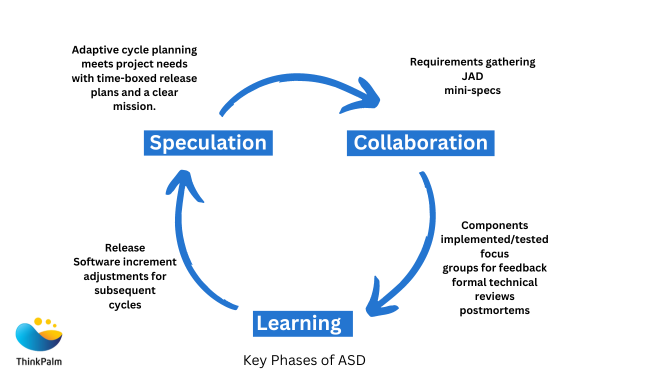Every software needs to be updated with changes in technology, user needs, and security concerns. Have you ever wondered how this can be achieved? Adaptive Software Development (ASD) is the perfect answer to that question which embraces change rather than following strict guidelines.
This was developed by Jim Highsmith and Sam Bayer. As changes arise, adaptive software development focuses on flexibility and continuous improvement that can be upgraded with time.
If you are a curious tech enthusiast or a developer who wants to learn more about this fantastic software development approach, you’re in for a treat.
In this blog, we’ll explore ASD and see how it keeps the software fresh and updated in this dynamic tech world we live in!
Adaptive Software Development (ASD) is an approach that focusses on change as a normal part of the process while building complex software systems. It focusses on teamwork and their ability to organize itself instead of following rigid plans.
ASD emerged from rapid application development (RAD) aimed at reducing development cycles. Jim Highsmith and Sam Bayer further expanded RAD. So, primarily, the ASD process covers three phases:
These three phases help teams adapt to changes and continuously improve the software they develop. These are explained as following below to help you understand better:

Key Phases of Adaptive Software Development
* This is the starting point of a project and involves planning based on project requirements and user needs that they currently know.
* Sets up a series of stages for releasing parts of the project instead of a long-term roadmap knowing that assumptions would change with time. This allows teams to adjust priorities easily whenever new insights occur.
* This phase is quite demanding as it depends upon highly motivated team workers.
* Moreover, it promotes openness and greater interaction with team members at the same time respecting individual creativity.
* Developing trust among team members helps in:
This phase forms the essence of Adaptive Software Development as teams can correct their assumptions with time.
* Workers who believe that they know more about technology could invite problems. This phase helps gain better clarity about uncovering the gaps.
* Furthermore, learning fosters their understanding of the project details in an enhanced manner
Learning happens through:
* Group discussions
* Technical reviews
* Reflecting on past efforts of project after each phase or release for improved outcome.
Let our experts help you map the right methodology to your business objectives. Read in our blog on Top 12 Software Development Methodologies for Your Project.
* ASD (Adaptive Software Development): Gives focus on teamwork and flexibility. There is a possibility for constant updates and prototypes being implemented to improve software.
* DSDM (Dynamic Systems Development Method): Prioritizes fixed timelines and helps with strong decision-making along with team ownership.
* XP (Extreme Programming): Closely involves customers throughout the developmental process so that necessary changes and improvisations are made based on ongoing feedback.
* SCRUM: Develops software based on short, iterative sprints, with regular team check-ins and reviews.
Overall, we can summarize by saying that ASD proves to stand out from other agile frameworks in terms of its emphasis on adaptability and continuous improvement. Whereas other methodologies have an upper hand when it comes to strict timelines, customer focus, or iterative cycles.
Listed below are some of the advantages and disadvantages of ASD in simpler terms:
Benefits of adaptive software development include:
Limitations of adaptive software development include:
Looking for expert software developemnt support in the UK? Explore how ThinkPalm delivers adaptive, future-ready software development services for businesses across the region.
There are several factors to consider when choosing ASD as your development framework:
ASD could be suitable if:
However, another agile framework might be more suitable if:
So, choosing ASD or another agile framework depends on aligning these considerations with your project’s specific needs and capabilities.
ThinkPalm is a product engineering and Software Development company globally recognized for leveraging Adaptive Software Development (ASD) to enhance flexibility, teamwork, and continuous improvement. Even though we employ other proven methodologies and approaches, ASD remains pivotal. Additionally, the applications that evolve as per changing needs boosts operational efficiency and deliver value to customers.
Above all, companies need to move ahead with the changing times and stay updated to attain a competitive edge. If quality needs to be of primary focus to our clients, there is a dire need to be updated. Therefore, it is of utmost importance that we make the most advanced tools and techniques. The final output? It equips us to provide robust, scalable, and future-proof software solutions completed accurately, in a timely manner and within budget limits. Eventually, this drives success for your business.
What is an adaptive approach to software development?
An adaptive approach in software development emphasizes flexibility and responsiveness to change. Moreover, it’s about adjusting plans, processes, and priorities based on ongoing feedback and evolving requirements, ensuring the final product meets the current needs effectively. Therefore, this approach is particularly valuable in dynamic environments where requirements may change frequently or where innovation and experimentation are key.
What is the difference between ASD and DSDM in software engineering?
ASD emphasizes flexibility, collaboration, and continuous adaptation, which are ideal for evolving projects. On the other hand, the dynamic systems development method (DSDM) focuses on quick delivery through time-boxed iterations and active user involvement, ensuring alignment with business goals. In fact, both are agile methodologies but differ in their approaches to managing software development.
What model is often referred to as adaptive software development?
The model often referred to as Adaptive Software Development (ASD) is the Rapid Application Development (RAD) model. However, RAD focuses on quickly developing prototypes with active user involvement. It allows for flexibility and rapid changes. Therefore, this approach uses fast planning, development, and feedback cycles to ensure the final product meets user needs, making it a prime example of adaptive software development.